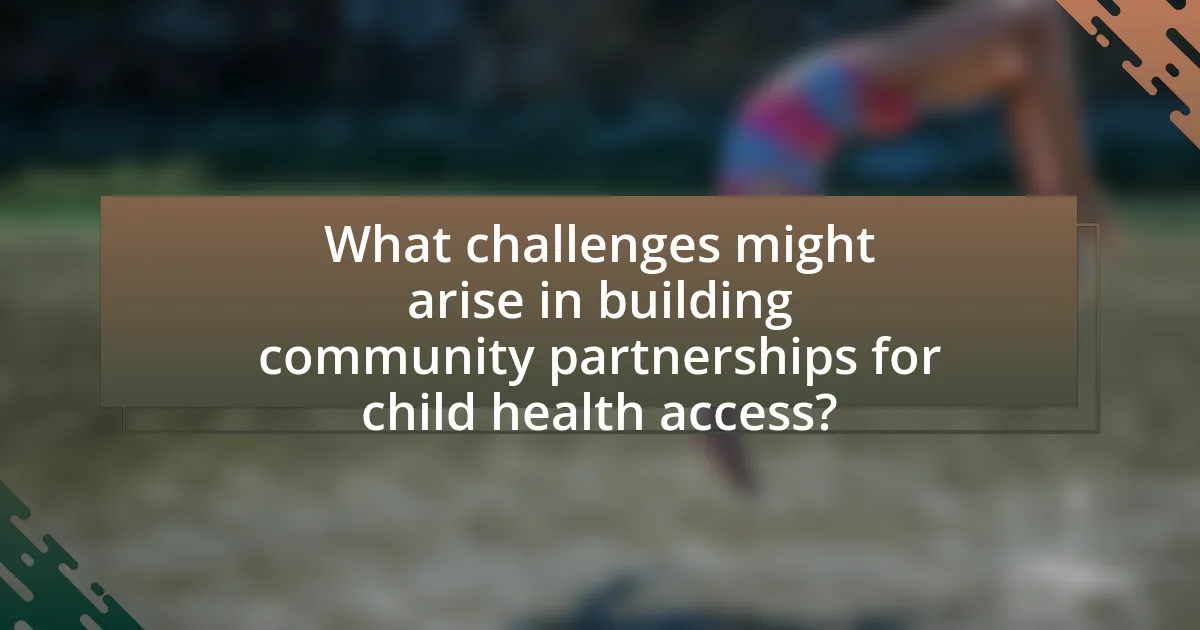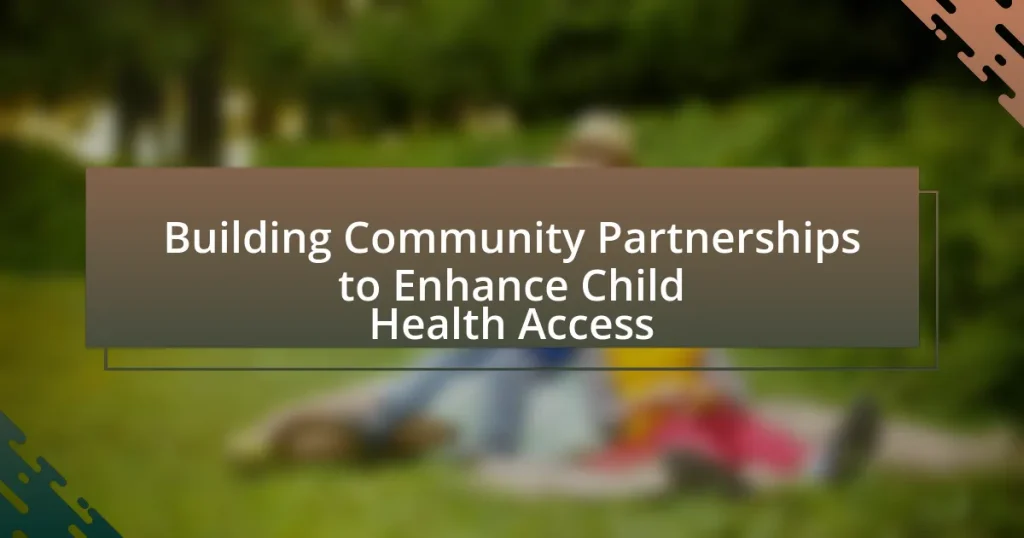Community partnerships in child health access are collaborative efforts that involve healthcare providers, community organizations, and families working together to improve health service availability and quality for children. These partnerships address barriers to healthcare access, such as socioeconomic factors and geographic challenges, leading to enhanced health outcomes, including increased immunization rates and better management of chronic conditions. The article explores the roles of local organizations, strategies for collaboration, and the importance of effective communication in building and maintaining these partnerships. It also discusses the challenges faced in establishing these collaborations and the implications of failing to do so, emphasizing the necessity of community engagement in promoting child health.

What are Community Partnerships in Child Health Access?
Community partnerships in child health access are collaborative efforts between healthcare providers, community organizations, and families aimed at improving the availability and quality of health services for children. These partnerships leverage local resources, knowledge, and networks to address barriers to healthcare access, such as socioeconomic factors, cultural differences, and geographic challenges. Evidence shows that such collaborations can lead to increased immunization rates, better management of chronic conditions, and enhanced overall health outcomes for children, as demonstrated in studies like the “Community-Campus Partnerships for Health” initiative, which highlights successful models of community engagement in health promotion.
How do community partnerships contribute to child health access?
Community partnerships significantly enhance child health access by facilitating resource sharing and improving service delivery. These collaborations often involve local organizations, healthcare providers, and community leaders working together to identify and address specific health needs of children. For instance, a study published in the American Journal of Public Health found that community-based interventions, such as school health programs and local health fairs, increased access to preventive care services for children by 30%. By leveraging local knowledge and resources, community partnerships can effectively reduce barriers to healthcare, such as transportation issues and lack of awareness about available services.
What roles do local organizations play in these partnerships?
Local organizations serve as vital connectors in partnerships aimed at enhancing child health access. They facilitate collaboration between various stakeholders, including healthcare providers, schools, and families, ensuring that resources and services are effectively aligned with community needs. For instance, local organizations often conduct needs assessments to identify gaps in health services, which informs the development of targeted interventions. Additionally, they mobilize community members, fostering engagement and participation in health initiatives, which has been shown to improve health outcomes. Research indicates that community-based organizations can increase access to health services by 30% through outreach and education efforts, demonstrating their crucial role in these partnerships.
How can healthcare providers collaborate with community partners?
Healthcare providers can collaborate with community partners by establishing formal partnerships that focus on shared goals, such as improving child health access. These collaborations often involve joint initiatives, resource sharing, and coordinated care efforts that leverage the strengths of both healthcare providers and community organizations. For instance, a study published in the American Journal of Public Health highlighted that partnerships between hospitals and local schools led to increased health screenings and educational programs, demonstrating the effectiveness of such collaborations in enhancing health outcomes for children.
Why are community partnerships essential for enhancing child health?
Community partnerships are essential for enhancing child health because they facilitate resource sharing, improve access to services, and foster a supportive environment for families. These collaborations bring together healthcare providers, schools, local organizations, and families to address the multifaceted needs of children. Research indicates that communities with strong partnerships experience better health outcomes, as evidenced by a study published in the American Journal of Public Health, which found that community engagement in health initiatives led to a 20% increase in immunization rates among children. This demonstrates that effective partnerships can mobilize resources and create tailored interventions that directly benefit child health.
What specific health outcomes improve through these partnerships?
Partnerships aimed at enhancing child health access lead to improved health outcomes such as increased vaccination rates, better management of chronic conditions, and enhanced mental health support. For instance, studies have shown that community partnerships can increase immunization coverage by up to 20%, thereby reducing the incidence of vaccine-preventable diseases. Additionally, collaborative efforts often result in more effective management of conditions like asthma, with programs demonstrating a 30% reduction in emergency room visits among participating children. Furthermore, these partnerships can provide critical mental health resources, leading to a 25% improvement in reported mental well-being among children in underserved communities.
How do partnerships address barriers to healthcare access for children?
Partnerships address barriers to healthcare access for children by leveraging resources, expertise, and networks to create comprehensive support systems. These collaborations often involve healthcare providers, community organizations, schools, and families, which collectively work to identify and mitigate obstacles such as transportation issues, financial constraints, and lack of awareness about available services. For instance, a study by the American Academy of Pediatrics highlights that community partnerships can improve access to preventive care by providing mobile clinics and outreach programs, effectively reaching underserved populations. This collaborative approach not only enhances service delivery but also fosters trust within communities, leading to increased utilization of healthcare services among children.

What strategies can be employed to build effective community partnerships?
To build effective community partnerships, organizations should prioritize clear communication, shared goals, and mutual respect. Establishing open lines of communication ensures that all stakeholders understand each other’s needs and expectations, which fosters trust. Setting shared goals aligns the efforts of different partners, creating a unified direction for initiatives. Additionally, demonstrating mutual respect for each partner’s contributions and expertise enhances collaboration and commitment. Research indicates that partnerships with these characteristics are more likely to succeed, as evidenced by the Community-Campus Partnerships for Health, which highlights the importance of these strategies in enhancing health access for children.
How can stakeholders identify potential partners in the community?
Stakeholders can identify potential partners in the community by conducting a thorough assessment of local organizations, resources, and needs. This involves mapping existing community assets, such as non-profits, healthcare providers, and educational institutions, which can be achieved through community surveys and stakeholder interviews. Research indicates that collaboration with local entities enhances resource sharing and improves health outcomes; for instance, a study published in the American Journal of Public Health highlights that partnerships between health organizations and community groups lead to increased access to health services for children. By leveraging these assessments and existing data, stakeholders can effectively pinpoint organizations that align with their goals in enhancing child health access.
What criteria should be used to evaluate potential partners?
To evaluate potential partners in building community partnerships to enhance child health access, criteria should include alignment of mission and values, capacity and resources, experience and expertise, and community reputation. Alignment of mission and values ensures that partners share a common goal of improving child health, which is critical for effective collaboration. Capacity and resources refer to the partner’s ability to contribute financially, logistically, and in terms of manpower, which is essential for the sustainability of initiatives. Experience and expertise in child health or related fields indicate that the partner can provide valuable insights and effective strategies. Community reputation reflects the partner’s standing within the community, which can influence trust and engagement from stakeholders. These criteria are supported by research indicating that successful partnerships often hinge on shared objectives and complementary strengths, as highlighted in studies on collaborative health initiatives.
How can trust be established among partners?
Trust can be established among partners through consistent communication and shared goals. Regular, transparent dialogue fosters understanding and alignment, while collaborative efforts towards common objectives reinforce commitment. Research indicates that partnerships with clear expectations and mutual respect are more likely to succeed, as evidenced by studies showing that effective communication increases trust levels significantly in collaborative environments.
What are the best practices for maintaining community partnerships?
The best practices for maintaining community partnerships include regular communication, mutual respect, and shared goals. Regular communication ensures that all parties are informed and engaged, fostering transparency and trust. Mutual respect involves recognizing the strengths and contributions of each partner, which enhances collaboration. Shared goals align the efforts of all partners towards common objectives, increasing the effectiveness of the partnership. Research indicates that partnerships with clear, shared goals are more likely to succeed, as they provide a framework for accountability and collective action. For instance, a study published in the American Journal of Community Psychology highlights that effective communication and shared objectives significantly improve partnership sustainability and outcomes in community health initiatives.
How can communication be optimized among partners?
Communication can be optimized among partners by establishing clear channels and protocols for information sharing. Effective communication requires regular meetings, defined roles, and the use of collaborative tools that facilitate real-time updates and feedback. Research indicates that organizations with structured communication strategies experience a 25% increase in project efficiency, demonstrating the importance of clarity and consistency in interactions.
What methods can be used to assess partnership effectiveness?
To assess partnership effectiveness in building community partnerships to enhance child health access, methods such as surveys, interviews, and performance metrics can be utilized. Surveys can gather quantitative data on stakeholder satisfaction and perceived impact, while interviews provide qualitative insights into partnership dynamics and challenges. Performance metrics, including health outcomes and service utilization rates, offer concrete evidence of the partnership’s effectiveness in achieving its goals. Research indicates that these methods collectively provide a comprehensive evaluation framework, enabling stakeholders to identify strengths and areas for improvement in their collaborative efforts.

What challenges might arise in building community partnerships for child health access?
Building community partnerships for child health access may face challenges such as differing priorities among stakeholders, resource limitations, and communication barriers. Stakeholders, including healthcare providers, community organizations, and families, often have varying goals that can lead to conflicts in partnership objectives. Resource limitations, including funding and personnel, can hinder the ability to implement effective programs. Additionally, communication barriers, such as language differences or lack of trust, can impede collaboration and information sharing. These challenges can ultimately affect the effectiveness of initiatives aimed at improving child health access.
How can conflicts between partners be resolved?
Conflicts between partners can be resolved through open communication, active listening, and collaborative problem-solving. Open communication allows partners to express their feelings and perspectives without fear of judgment, fostering an environment where issues can be addressed constructively. Active listening ensures that each partner feels heard and understood, which is crucial for de-escalating tensions. Collaborative problem-solving involves both partners working together to identify solutions that satisfy the needs of both parties, promoting a sense of teamwork and shared goals. Research indicates that effective conflict resolution strategies can lead to stronger partnerships and improved outcomes in community health initiatives, as evidenced by studies showing that organizations with strong communication practices report higher levels of satisfaction and success in collaborative efforts.
What strategies can mitigate misunderstandings among stakeholders?
Effective communication strategies can mitigate misunderstandings among stakeholders. These strategies include establishing clear objectives, utilizing active listening techniques, and fostering an environment of open dialogue. Research indicates that when stakeholders engage in regular meetings with defined agendas, misunderstandings decrease significantly, as seen in the study by O’Leary and Bingham (2009) in the “Journal of Public Administration Research and Theory,” which emphasizes the importance of structured communication in collaborative settings. Additionally, employing visual aids and written summaries can enhance comprehension and retention of information, further reducing the potential for miscommunication.
How can resource limitations impact partnership effectiveness?
Resource limitations can significantly hinder partnership effectiveness by restricting the availability of essential tools, funding, and personnel needed to achieve common goals. When partners lack adequate resources, they may struggle to implement programs, maintain communication, and fulfill commitments, leading to decreased trust and collaboration. For instance, a study by the National Collaborating Centre for Determinants of Health found that partnerships with insufficient financial backing often fail to sustain initiatives, resulting in diminished outcomes in community health projects. This evidence illustrates that resource constraints directly correlate with the ability of partnerships to function effectively and achieve desired health access improvements for children.
What are the implications of failing to establish community partnerships?
Failing to establish community partnerships can lead to significant negative implications for child health access. Without these partnerships, organizations may struggle to effectively identify and address the specific health needs of children within the community, resulting in inadequate health services and resources. Research indicates that communities with strong partnerships experience improved health outcomes, as collaboration fosters resource sharing and enhances service delivery. For instance, a study published in the American Journal of Public Health found that community engagement in health initiatives leads to a 25% increase in service utilization among children. Thus, the absence of community partnerships can perpetuate health disparities and limit access to essential services for vulnerable populations.
How does lack of collaboration affect child health outcomes?
Lack of collaboration negatively impacts child health outcomes by creating gaps in access to essential services and resources. When healthcare providers, educators, and community organizations do not work together, children may miss out on preventive care, timely interventions, and comprehensive support systems. For instance, a study published in the American Journal of Public Health found that communities with strong collaborative networks reported lower rates of childhood obesity and improved vaccination coverage, highlighting the importance of integrated efforts in promoting child health. Without such collaboration, disparities in health outcomes can widen, leading to increased morbidity and long-term health issues among children.
What long-term consequences can arise from inadequate health access?
Inadequate health access can lead to long-term consequences such as increased morbidity and mortality rates. Individuals lacking access to healthcare services often experience untreated chronic conditions, which can result in complications and a higher likelihood of premature death. For instance, a study published in the American Journal of Public Health found that uninsured individuals are 25% more likely to die prematurely compared to those with health insurance. Additionally, inadequate health access can contribute to a cycle of poverty, as untreated health issues can hinder employment opportunities and economic stability. This cycle perpetuates health disparities, particularly among marginalized communities, leading to a sustained impact on overall community health and well-being.
What practical steps can organizations take to enhance child health access through partnerships?
Organizations can enhance child health access through partnerships by implementing collaborative programs that integrate health services with community resources. For instance, establishing partnerships with local schools can facilitate health education and screenings, directly reaching children and their families. Additionally, collaborating with non-profit organizations can provide resources for nutrition and mental health services, addressing holistic child health needs. Evidence shows that community-based interventions, such as the “Healthy Start” initiative, have successfully improved access to healthcare for children by leveraging local partnerships, resulting in increased immunization rates and better health outcomes.
